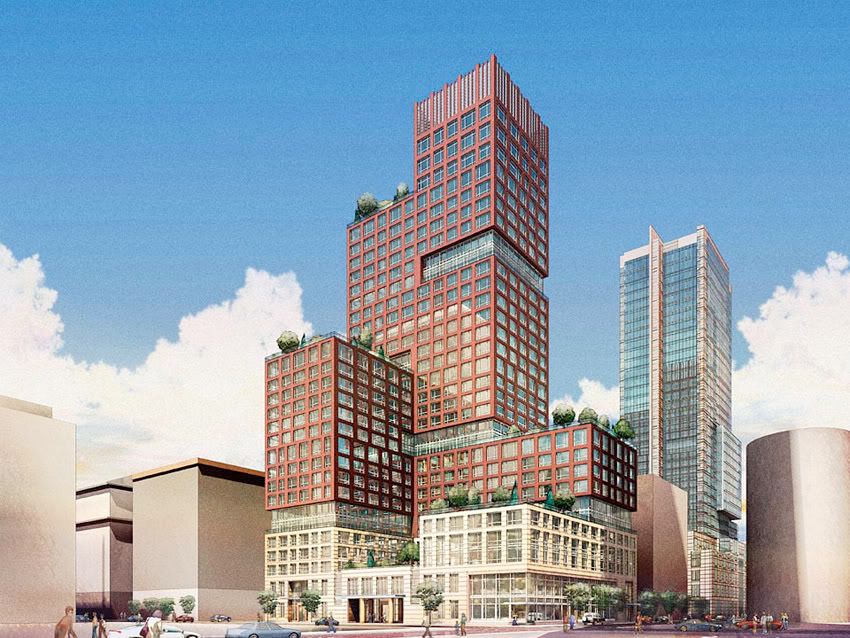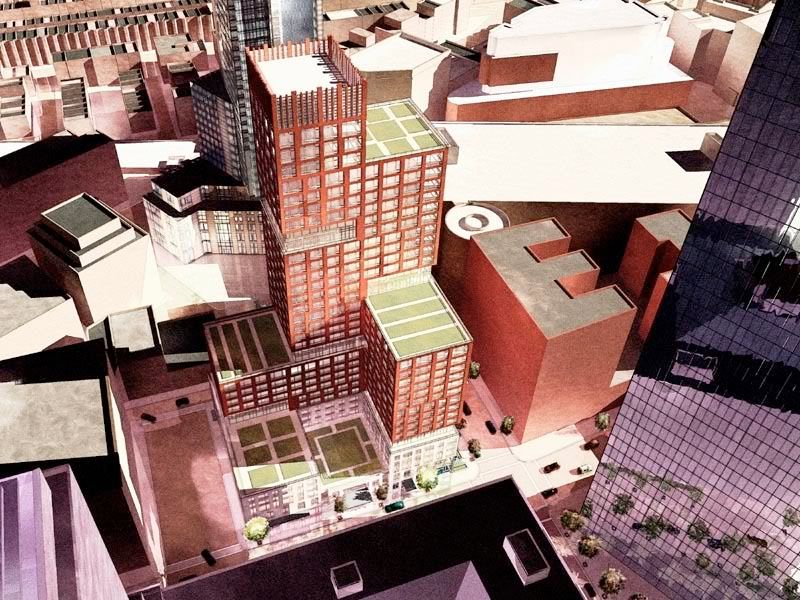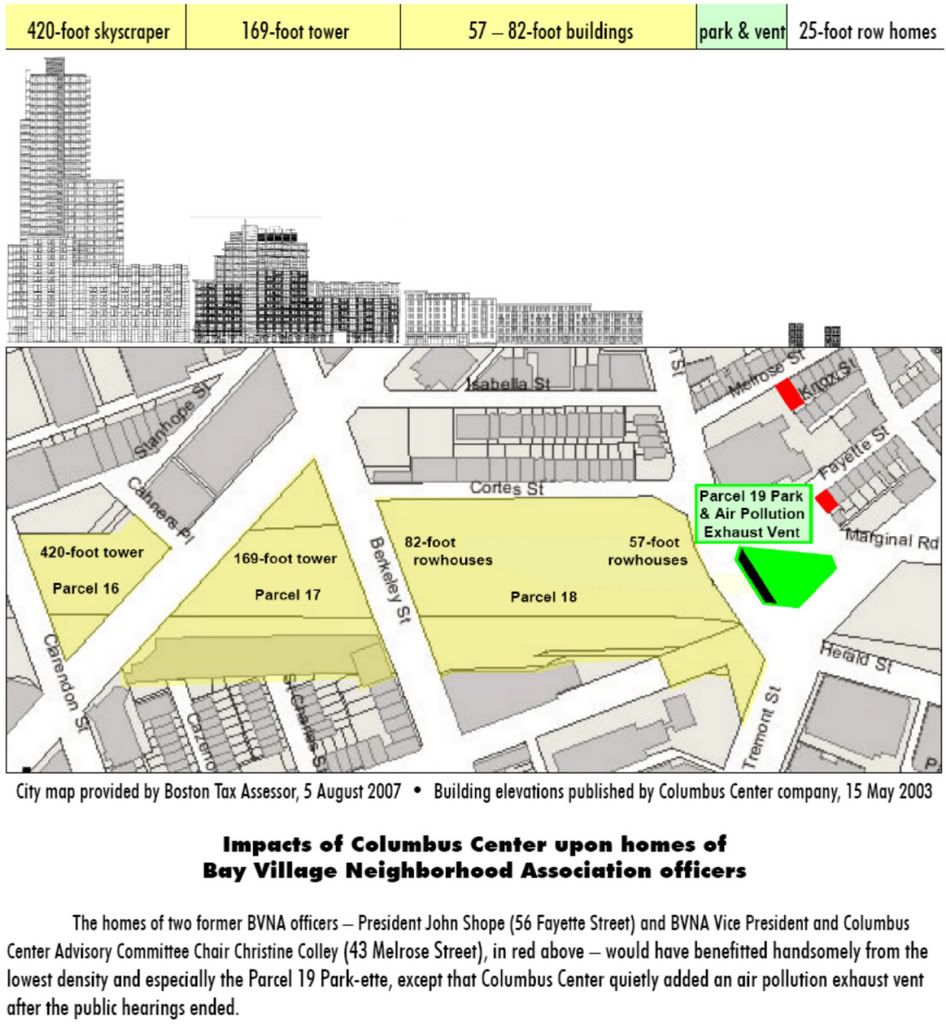Replies for TC, DarkFenX, Statler, Chumbolly, and Atlantaden...
Q-33. Must we choose between ?filling the canyon? and ?cleansing the air??
A-33. No. The canyon can be filled ? and it should be,
and the air can be cleansed ? and it must be, because the federal Clean Air Act of 1990 requires protection of all adjacent human beings from the amounts and types of pollution now slated to surround air rights sites city-wide.
Q-34. TC asks, ?If you had to choose between Columbus Center?s latest proposal versus an exposed transportation corridor for 100 more years, which would you choose??
A-34. Those are the two worst scenarios, and nobody has to accept either of them. Framing the debate around only the two worst options is unnecessary ? and irresponsible. Columbus Center is a 12-year-old paper proposal requiring so much public subsidy that it never broke ground. Here?s what should have happened, and what should happen now. MTA should obtain at least three genuine, competitive proposals, with financial disclosure, that comply with the Master Plan. The best one should be selected by a fair and open public process that avoids the eight failures which caused the current dilemma:
? (1) The Mayor?s advisory committee seats must never again be owned by proponents.
? (2) The public process calendar must never again be dictated by the proponents.
? (3) Public hearing transcripts must never again be edited by proponents.
? (4) Public hearings must never again be secretly recorded by anyone.
? (5) Citizens must be able to record public hearings as outlined in the Open Meeting law.
? (6) Public subsidies must never again be concealed.
? (7) The MTA vent study must be published before public hearings start, not after they?ve ended.
? (8) Proposals that violate the Master Plan must never again be approved.
Q-35. Is higher density harmful to this area?
A-35. Yes. Most of the nearby streets were sized before long cars were invented, then built around, and so can never be widened. To a 2-block stretch that already suffers frequent gridlock, Columbus Center proposes to add 917 more parking spaces supporting at least 3,000 more daily trips, which will increase each year thereafter.
Q-36. How does a 2-acre park offset excess density?
A-36. It trades one damaging impact for another beneficial impact. Parks and density can?t literally cancel each other out because they?re completely different elements, but profits from the damaging one (density) can enable the beneficial one (parks). When the owner of a stolen but insured family heirloom diamond gets compensated by an insurance reimbursement, everyone knows the cash can never reverse the theft, but it does the next best thing by compensating in ways that are left to the victim to choose. In this case, the Master Plan specified that damage from excess density must be compensated for by reimbursing the victim ? the public realm ? with open space.
Q-37. Should we demolish some Louisburg Square row homes to widen its park?
A-37. No. The homes are already rightfully owned, and buying them back is too costly for the few feet of open space that would result. It?s too late to expand the park now, but everyone would be grateful today if, in 1840, the creators had built more open space for future generations to enjoy.
Q-38. How would condominium owners avoid paying MTA?s 1% re-sale tax?
A-38. The loopholes can?t be identified until a few years from now, after the new 99-year lease is executed and the condominium documents are published. On 7 April 2007 the new owners claimed they?d already secured a new MTA lease last winter, but MTA won?t confirm or deny anything until after it?s too late for the public or state government to have any impact. Also, condominium documents are usually finished just before sales start. So defining the exact loopholes will have to wait a few years.
Some facts are known, however. The 451 condominiums total 984,847 s.f., average 2,184 s.f., and are slated to sell for $1 - $3 million. People who own such apartments also have accountants and lawyers whose core business is redefining assets to avoid taxes. They?ll surely spend a few hours to avoid that $10,000-$30,000 tax. Common methods already in use include:
? (a) making a condominium an asset of a corporation that always owns it so that the corporation may change hands but the condominium owner remains the corporation, which keeps the re-sale tax from ever coming due;
? (b) making a condominium an asset of a Trust which always owns it so that the Trustee may rotate but the condominium owner always remains the Trust, which keeps the re-sale tax from ever coming due;
? (c) making a condominium a family-run ?charity?; etcetera.
I haven?t done any of the above, and am not suggesting anyone should cheat the MTA which is part of the Commonwealth, but such asset reclassification techniques are common among the well-heeled.
Q-39. What other neighborhood groups endorsed or opposed the Columbus Center proposal?
A-39. During the height of the public hearings, Columbus Center was opposed by the largest and most representative organizations: Conservation Law Foundation, Boston Preservation Alliance, Committee for Responsible Turnpike Development, Neighborhood Association of the Back Bay, South End Ellis Neighborhood Association, Bay Village Neighborhood Association, Claremont Neighborhood Association, Stanhope Street Improvement Association, Union Park Neighborhood Association, and Old Dover Neighborhood Association.
Several small non-profits became ardent endorsers, but only after Columbus Center promised them cash, which they omitted from their endorsement letters.
Q-40. Why did Bay Village first align with its neighbors in opposition, and then reverse itself and become an endorser?
A-40. The developers promised BVNA officers the lowest density as close to them as possible, the highest density as far away as possible, and a park-ette at their homes. The developers promised BVNA President John Shope (56 Fayette Street) and BVNA Vice President & Citizens Advisory Committee Chair Christine Colley (43 Melrose Street) that Columbus Center would put the most dense elements as far from their homes as possible, put the least dense elements as close to their homes as possible, and create a park-ette in front of Shope?s home and one block from Colley?s home. Once assured of those promises, BVNA officers reversed their position from opposing to endorsing.
Q-41. Are Bay Village residents less informed?
A-41. Yes. It?s not clear if the NIMBY-ism of refusing density and demanding a park-ette is only the work of Shope and Colley, or also involves subsequent BVNA officers, and/or members. What is clear, however, is that Bay Village residents have heard nothing from their association officers about:
? (a) the 15 air pollution exhaust vents citywide (my Q&A #2 with map);
? (b) the 5 air pollution exhaust vents at Columbus Center (my Q&A #10 with model); or
? (c) the fact that on 9 March 2006 the promised public parks were made into private gardens with no public recourse (my Q&A #11).
Q-42. What is former BVNA Vice President Christine Colley?s role now?
A-42. The BRA pays Colley to fix promises that BRA and developers break. Shortly after sherpherding Columbus Center?s approval vote through the developer-owned seats on the Mayor?s Advisory Committee that she chaired, Colley was rewarded with a BRA job that has paid her so far over $300,000, plus benefits, plus free parking on public school property next to her home. In 2004, BRA Director Mark Maloney said that after multiple exhaustive searches, he?d chosen Colley as the best imaginable candidate for a ?Promise Keeper? to rectify the 50-year history of the BRA and its developers making and breaking promises.
Colley has an unprecedented opportunity to rectify the damage that she and Shope helped cause, because now it?s her job. She should force the developer to deliver a park-ette that matches the one promised in the pretty water color drawings, i.e., one where all the air is safely breathable by humans and their pets. And she should ensure that all 5 of Columbus Center?s air pollution exhaust vents deliver the ?cleaner air? that the developer repeatedly promised in videotapes, audiotapes, meeting minutes, proposals, and public subsidy applications. She needs do no research, because those promises are all on file in her own office.




